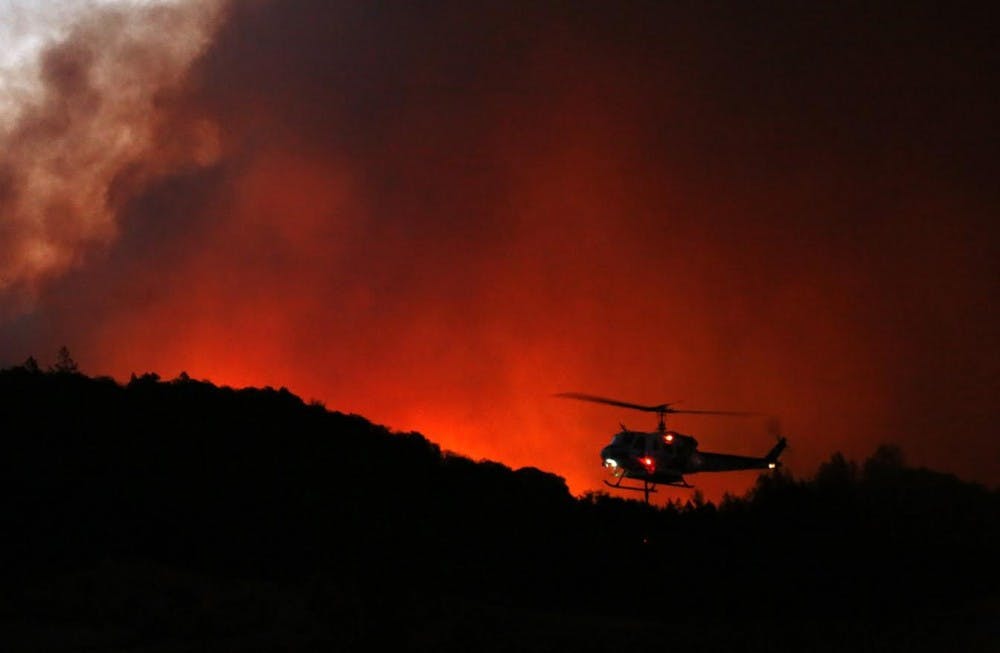For over a week, portions of southern and northern California have been engulfed in flames. Wildfires in southern California have started to subside, but 10 fires still remain active — mostly in the north.
According to CAL FIRE, a resource for tracking wildfires provided by the state of California, the fires range in containment levels from Vista Fire at 50 percent containment to LaPorte Fire at 98 percent containment.
CAL FIRE also stated that as of Tuesday Oct. 24, the death toll was 42, and over 8, 400 structures had been destroyed.
Communications junior Emily Andersen is from Sherman Woods, California, a suburb of Los Angeles. She believes that the recovery efforts need to come from local government.
“I really think since California’s known for being in a drought right now, and there’s not a lot of access to water, it’s a really big solution to what could help with the fires, but I know federally for example, (President Donald) Trump has not talked about the fires at all, like whatsoever," Andersen said. "As far as a solution, I think it needs to start from a smaller level to make sure that everyone is taken care of with access to water, food, shelter especially, and transporting these people that need to get away and evacuate.”
James Madison freshman Samuel Blatchford is from Santa Ana in Orange County, California. He described the tumult last week as he tracked a fire near his family's home.
“The one in southern California, they just put out last week," Blatchford said. "I have a friend who’s still in high school and I was on his Snapchat and I’m like, whoa, because it said something about evacuation."
Blatchford said he texted his parents and got no reply, so he looked up information about the fires on the internet.
"I go to the map and that’s like two miles away from our house,” he said.
As the fires began in northern California, Andersen's mother contacted her about the situation.
“My mom had immediately texted me," Andersen said. "We have family and friends who live in northern California who are okay, but have to wear masks and make sure they aren’t working outside for too long. None of them have had to move right now, but they might have to move.”
Blatchford also noted that the destruction in Napa Valley has impacted him as well.
“I have a family friend who lives up there, and one of my brothers goes to camp up there every summer and almost half of it burned to the ground," Blatchford said.
He noted that northern California's fires have been more damaging.
“The northern California one is worse than the southern California one," Blatchford said. "They’ve found a mass of people that had been in the homes that have been destroyed. The one in southern California started near a freeway, and although some structures were damaged, not a lot. A lot of people died in northern California one.”
Upon hearing about the proximity of the fire to his home, Blatchford called his parents.
“After I found out that information, I called them and asked, ‘What’s up? I’m like, worried now.’ I look at — there was a map online that said real-time almost, and so I’m like, ‘Is this really like five blocks away?’ They’re like, ‘Oh yeah, it’s no big deal.’”
Fire season in California traditionally lasts from September to November. According to National Public Radio, this is no longer the case. Because of California's drought, the risk of wildfires exists year round, making experiences with fires common — and making them less shocking to Californians.
Andersen relayed the story of a fire three weeks ago that occurred near her home.
“We actually just got done with a set of fires that happened about three weeks ago and they were affecting a lot of places my friends live," Andersen said. "It wasn’t the valley, so people were directly affected in the mountain areas, and I have a lot of friends in the mountains, and so they had to evacuate. My mom had to wear masks around the area.”
Support student media!
Please consider donating to The State News and help fund the future of journalism.
Blatchford also affirmed that they're used to dealing with wildfires.
“There was a really bad one in El Dorado, which is like five miles away in, I want to say June," Blatchford said. "I was actually driving back from work at 11, and I could see little white embers hitting the windshield. I open the doors at about 11:30, and I run up to my mom and I’m like, ‘Is there a fire somewhere?’ and she’s like, ‘What?’ You could smell it .. so, she thought the house was burning down, but I was like, ‘Well, there’s a fire somewhere.’ But, we’re used to it.”
In spite of not being terrified by the fire, Blatchford's parents did evacuate, and waited out the fire at a local restaurant.
“I asked my mom, ‘How is the evacuation process?’" Blatchford said. "And she’s like, ‘Well, the police came, knocked on the door, and said, ‘We’re just letting you know that we think you should evacuate. The fire’s like inching close. We’re going to come back again whenever we make our rounds and knock again and remind you again to evacuate. You don’t have to, but we really strongly urge you to evacuate, but you don’t have to. That’s basically their way of saying, ‘Listen, we really want you to get out for your safety.’ So, what my parents did is when they left, they left a note saying like, ‘Hey, we’re gone. Don’t come in.’”
After the fact, they found out the fire had reached within 100 feet of their house.
Discussion
Share and discuss “Californian Spartans react to the wildfires” on social media.







